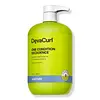What's inside
What's inside
 Key Ingredients
Key Ingredients

 Benefits
Benefits

 Concerns
Concerns

No concerns
 Ingredients Side-by-side
Ingredients Side-by-side

Water
Skin ConditioningCetearyl Alcohol
EmollientGlycerin
HumectantOlea Europaea Fruit Oil
MaskingCetyl Esters
EmollientCetrimonium Chloride
AntimicrobialBehentrimonium Chloride
PreservativeCitric Acid
BufferingEthylhexylglycerin
Skin ConditioningGuar Hydroxypropyltrimonium Chloride
Skin ConditioningIsopropyl Alcohol
SolventPolyquaternium-10
Sodium PCA
HumectantTocopherol
AntioxidantPhenoxyethanol
PreservativeParfum
MaskingAlpha-Isomethyl Ionone
PerfumingBenzyl Benzoate
AntimicrobialGeraniol
PerfumingLinalool
PerfumingWater, Cetearyl Alcohol, Glycerin, Olea Europaea Fruit Oil, Cetyl Esters, Cetrimonium Chloride, Behentrimonium Chloride, Citric Acid, Ethylhexylglycerin, Guar Hydroxypropyltrimonium Chloride, Isopropyl Alcohol, Polyquaternium-10, Sodium PCA, Tocopherol, Phenoxyethanol, Parfum, Alpha-Isomethyl Ionone, Benzyl Benzoate, Geraniol, Linalool
Water
Skin ConditioningHelianthus Annuus Seed Oil
EmollientGlycerin
HumectantGluconolactone
Skin ConditioningGlyceryl Stearate
EmollientPEG-100 Stearate
Sorbitol
HumectantSodium Acrylates Copolymer
Carbomer
Emulsion StabilisingSodium Hydroxide
BufferingPEG-40 Hydrogenated Castor Oil
EmulsifyingPersea Gratissima Oil
Skin ConditioningCaprylyl Glycol
EmollientLecithin
EmollientSodium Citrate
BufferingP-Anisic Acid
MaskingChlorphenesin
AntimicrobialAllantoin
Skin ConditioningSodium Hyaluronate
HumectantWater, Helianthus Annuus Seed Oil, Glycerin, Gluconolactone, Glyceryl Stearate, PEG-100 Stearate, Sorbitol, Sodium Acrylates Copolymer, Carbomer, Sodium Hydroxide, PEG-40 Hydrogenated Castor Oil, Persea Gratissima Oil, Caprylyl Glycol, Lecithin, Sodium Citrate, P-Anisic Acid, Chlorphenesin, Allantoin, Sodium Hyaluronate
Ingredients Explained
These ingredients are found in both products.
Ingredients higher up in an ingredient list are typically present in a larger amount.
Glycerin is already naturally found in your skin. It helps moisturize and protect your skin.
A study from 2016 found glycerin to be more effective as a humectant than AHAs and hyaluronic acid.
As a humectant, it helps the skin stay hydrated by pulling moisture to your skin. The low molecular weight of glycerin allows it to pull moisture into the deeper layers of your skin.
Hydrated skin improves your skin barrier; Your skin barrier helps protect against irritants and bacteria.
Glycerin has also been found to have antimicrobial and antiviral properties. Due to these properties, glycerin is often used in wound and burn treatments.
In cosmetics, glycerin is usually derived from plants such as soybean or palm. However, it can also be sourced from animals, such as tallow or animal fat.
This ingredient is organic, colorless, odorless, and non-toxic.
Glycerin is the name for this ingredient in American English. British English uses Glycerol/Glycerine.
Learn more about GlycerinWater. It's the most common cosmetic ingredient of all. You'll usually see it at the top of ingredient lists, meaning that it makes up the largest part of the product.
So why is it so popular? Water most often acts as a solvent - this means that it helps dissolve other ingredients into the formulation.
You'll also recognize water as that liquid we all need to stay alive. If you see this, drink a glass of water. Stay hydrated!
Learn more about Water